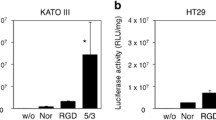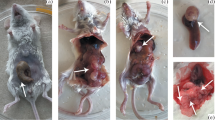Abstract
Several lines of evidence indicate that sialosyl Le a , tumor-associated carbohydrate antigen present on human colon carcinoma cells, is involved in formation of metastases. To study the role of this carbohydrate structure in development of metastases, we have used the clone of human colon carcinoma CX-1 cells transfected with antisense expression vector containing fragment of cDNA for a1,3/4-fucosyltransferase (FT III), which is involved in synthesis of sialosyl Le a tetrasaccharide. It has been reported previously that, in contrast to the parental cells, the antisense-transfected CX-1.1AS5 cells do not express sialosyl Le a and do not adhere to E-selectin-expressing CHO cells. In the present work we have studied the formation of liver metastases by CX-1.1AS5 cells after their orthotopic or intrasplenic implantation into athymic nu/nu mice. After orthotopic implantation of sialosyl Le a -negative colon carcinoma CX-1.1AS5 cells, the number of mice with liver metas-tases was markedly lower (21% of mice) in comparison with their number after implantation of the parental CX-1.1 cells (86% of mice). However, no differences in ability to form colonies in liver were observed between parental CX-1.1 cells and antisense-transfected CX-1.1AS5 cells after intrasplenic inoculation. The liver metastases were formed in 89% and 84% of mice, respectively. Our data support the thesis on the importance of sialosyl Le a antigen expression in the development of liver metastases by colon cancer cells, and indicate the role of transplantation route and primary tumor localization in formation of metastases.© Kluwer Academic Publishers 1998
Similar content being viewed by others
References
Hakomori S, 1989, Aberrant glycosylation in tumors and tumor-associated carbohydrate antigens. Adv Cancer Res, 52, 257-331.
Hakomori S, 1996, Tumor malignancy defined by aberrant glycosylation and sphingo(glyco)lipid metabolism. Cancer Res, 56, 5309-18.
Gong E, Hirohashi S, Shimosato Y, et al.1985, Expression of carbohydrate antigen 19-9 and stage-specific embryonic antigen 1 in non-tumorous and tumorous epithelia of the human colon and rectum. J Natl Cancer Inst, 75, 447-54.
Nakayama T, Watanabe M, Katsumata T, et al.1995, Expression of sialyl Lewisa as a new prognostic factor for patients with advanced colorectal carcinoma. Cancer, 75, 2051-56.
Yamada N, Chung YS, Maeda K, et al.1995, Increased expression of sialyl Le A and sialyl Lewis X in liver metastases of human colorectal carcinoma. Invasion & Metastasis, 15, 95-102.
Feizi T, 1993, Oligosaccharides that mediate mammalian cell-cell adhesion. Curr Opin Struct Biol, 3, 701-10.
Nelson RM, Dolich S, Aruffo A, et al.1993, Higher-affinity oligosaccharide ligands for E-selectin. J Clin Invest, 91, 1157-66.
Honn KV and Tang DG, 1992, Adhesion molecules and tumor cell interaction with endothelium and subendothelial matrix. Cancer Metastasis Rev, 11, 353-75.
Brandley BK, Swiedler SJ and Robbins PW, 1990, Carbohydrate ligands of the LEC cell adhesion molecules. Cell, 63, 861-3.
Pettijohn DE, Pfenninger O, Brown J, et al.1988, Tumorigenic human squamous lung cancer cells have defined cell surface carbohydrates that are absent from nontumorigenic cells. Proc Natl Acad Sci USA, 85, 802-806.
Inofusa H, Kojima M, Yasutomi M and Hakomori S, 1991, Human lung adenocarcinoma cell lines with different lung colonization potential (LCP), and a correlation between expression of sialosyl dimeric Lex (defined by MAb FH6) and LCP. Clin Exp Metastasis, 9, 245-57.
Izumi Y, Taniuch Y, Tsuji T, et al. 1995, Characterization of human colon carcinoma variant cells selected for sialyl Lex carbohydrate antigen: liver colonization and adhesion to vascular endothelial cells. Exp Cell Res, 216, 215-21.
Matsushita Y, Hoff SD, Nudelman ED, et al.1991, Metastatic behavior and cell surface properties of HT-29 human colon carcinoma variant cells selected for their differential expression of sialyl-dimeric Lex antigen. Clin Exp Metastasis, 9, 283-99.
Yamada N, Chung Y-S, Arimoto Y, et al.1997, Increased sialyl Lewis A expression and fucosyl-transferase activity with acquisition of a high metastatic capacity in a colon cancer cell line. Br J Cancer, 76, 582-7.
Sato M, Narita T, Kimura N, et al.1997, The association of sialyl Lewisa antigen with the metastatic potential of human colon cancer cells. Anticancer Res, 17, 3505-12.
Kłopocki A, Laskowska A, Antoniewicz-Papis J, et al.1998, Role of sialosyl Lewisa in adhesion of colon cancer cells, the antisense RNA approach. Eur J Biochem, 250, 309-18.
Wagner HE, Toth CA, Steele GD and Thomas P, 1992, Invasive and metastatic potential of human colorectal cancer cell lines: relationship to cellular differentiation and carcinoembryonic antigen production. Clin Exp Metastasis, 10, 25-31.
Goetz DJ, Ding H, Atkinson WJ, et al.1996, A human colon carcinoma cell line exhibits adhesive interactions with P-selectin under fluid flow via a PSGL-1-independent mechanism. Am J Pathol, 149, 1661-73.
Kojima N, Handa K, Newman W and Hakomori S, 1992, Inhibition of selectin-dependent tumor cell adhesion to endothelial cells and platelets by blocking O-glycosylation of these cells. Biochem Biophys Res Commun, 182, 1288- 95.
Majuri M-L, Matilla P and Renkonen R, 1992, Recombinant E-selectin-protein mediates tumor cell adhesion via sialyl Lea and sialyl Lex. Biochem Biophys Res Commun, 182, 1376-82.
Takada A, Ohmori K, Yoneda T, et al.1993, Contribution of carbohydrate antigens sialyl Lewis A and sialyl Lewis X to adhesion of human cancer cells to vascular endothelium. Cancer Res, 53, 354-61.
Kishimoto T, Ishikura H, Kimura C, et al.1996, Phenotypes correlating to metastatic properties of pancreas adenocarcinoma in vivo: the importance of surface sialyl Lewisa antigen. Int J Cancer (Pred Oncol), 69, 290-94.
Hansson GC and Zopf D, 1985, Biosynthesis of the cancer-associated sialyl-Lea antigen. J Biol Chem, 260, 9388-92.
Becker-Andre M, van Huijisduijnen RF, Losburger C, et al.1992, Murine endothelial leukocyte-adhesion molecule 1 is a close structural and functional homologue of the human protein. Eur J Biochem, 206, 401-11.
Sato M, Narita T, Kimura N, et al.1997, Interaction between human cancer cells and cultured murine endothelial cells, and its relationship with metastatic potential. Int J Cancer, 10, 1173-8.
Hashino J, Fukuda Y, Oikawa S, et al.1994, Metastatic potential of human colorectal carcinoma SW 1222 cells transfected with cDNA encoding carcinoembryonic antigen. Clin Exp Metastasis, 12, 324-8.
Thomas P, Gangopadhyay A, Steele G, et al.1995, The effect of transfection of the CEA gene on the metastatic behavior of the human colorectal cancer cell line MIP-101. Cancer Lett, 92, 59-66.
Thompson JA, Grunert F and Zimmermann W, 1991, Carcinoembryonic antigen gene family: molecular biology and clinical perspectives. J Clin Lab Anal, 5, 344-66.
Kubota T, 1994, Metastatic models of human cancer xenografted in the nude mouse: the importance of orthotopic transplantation. J Cell Biochem, 56, 4-8.
Author information
Authors and Affiliations
Rights and permissions
About this article
Cite this article
Opolski, A., Laskowska, A., Madej, J. et al. Metastatic potential of human CX-1 colon adenocarcinoma cells is dependent on the expression of sialosyl Le a antigen. Clin Exp Metastasis 16, 673–681 (1998). https://doi.org/10.1023/A:1006502009682
Issue Date:
DOI: https://doi.org/10.1023/A:1006502009682




